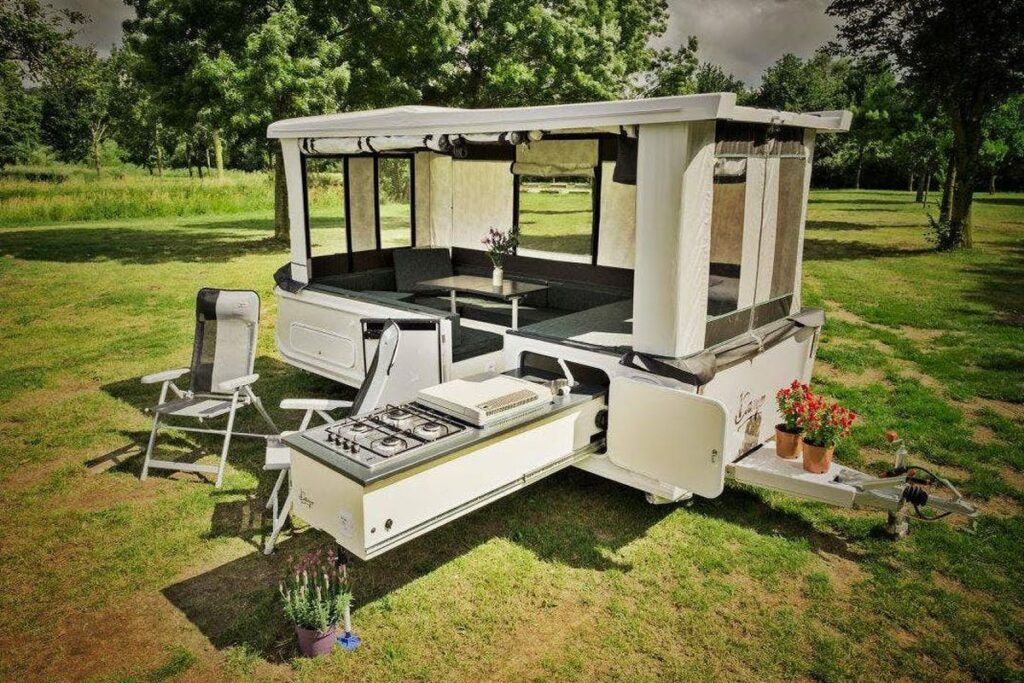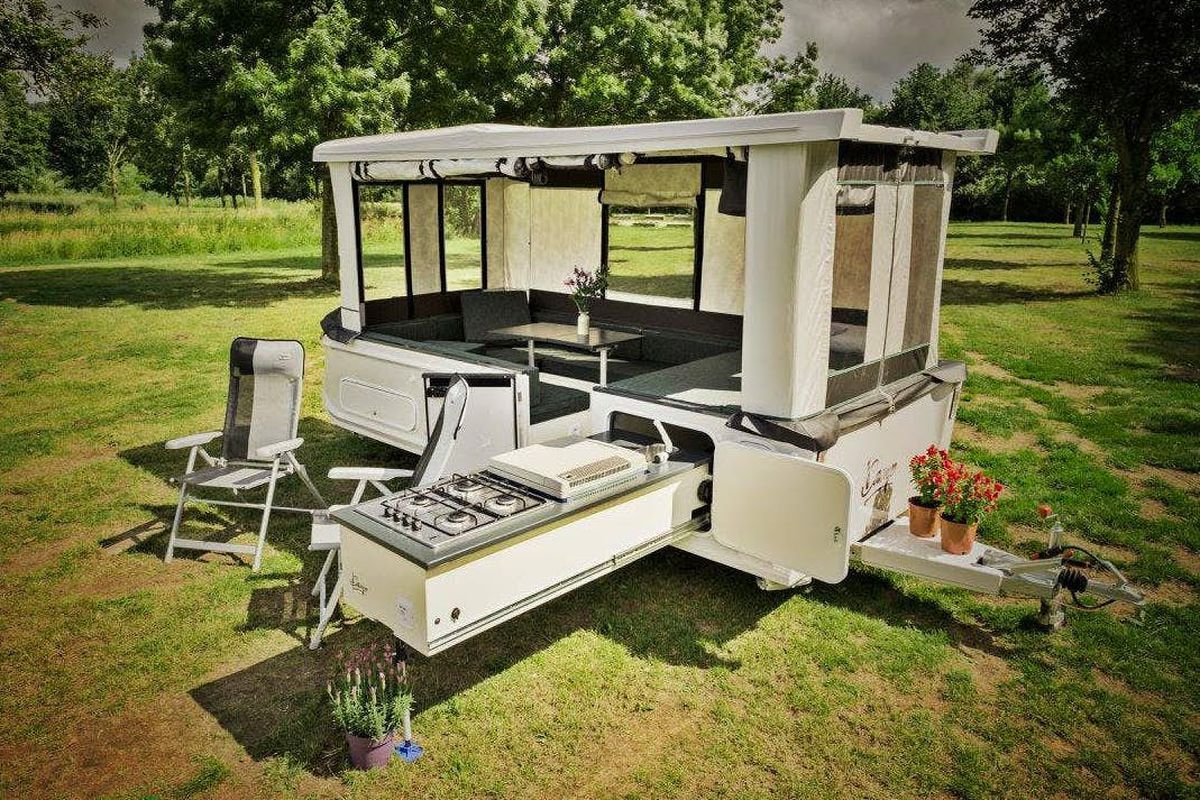
Slide-In Campers on Trailers: A Comprehensive Guide for Adventure Seekers
The allure of the open road, the freedom to explore, and the call of the wild are powerful motivators for many. For those seeking an immersive outdoor experience without sacrificing comfort and convenience, the combination of a slide-in camper on a trailer offers a compelling solution. This guide delves into the world of slide-in campers mounted on trailers, exploring their advantages, considerations, and providing valuable insights for prospective buyers and seasoned adventurers alike.
The concept is simple: a slide-in camper, designed to fit within the bed of a pickup truck, is instead placed on a trailer. This seemingly minor adjustment unlocks a world of possibilities, offering increased versatility, enhanced storage, and the potential for a more comfortable and customized camping experience. But is this setup right for you? Let’s explore the details.
Advantages of a Slide-In Camper on a Trailer
The choice to utilize a slide-in camper on a trailer presents several key advantages over the traditional truck bed setup:
- Increased Payload Capacity: One of the most significant benefits is the ability to bypass the payload limitations of a pickup truck. By placing the camper on a trailer, you’re offloading the weight, allowing for a larger, heavier camper or the inclusion of more gear. This opens the door to more luxurious amenities and greater storage capacity.
- Vehicle Versatility: This setup allows you to use a wider range of vehicles for towing. You’re not limited to owning a pickup truck. A properly equipped SUV, van, or even a smaller truck can be used to pull the trailer, broadening your options and potentially saving on vehicle costs.
- Improved Maneuverability: While towing a trailer adds a dimension to driving, the overall maneuverability might be better in certain situations. You can detach the trailer at a campsite and use your tow vehicle for local exploration, errands, or simply enjoying the freedom of a smaller vehicle.
- Enhanced Storage: The space freed up in your tow vehicle’s bed allows for additional storage. You can carry items like firewood, tools, or outdoor equipment separately, keeping your camper uncluttered and organized.
- Reduced Wear and Tear on Tow Vehicle: The weight distribution is optimized with a trailer, minimizing stress on the tow vehicle’s suspension, brakes, and drivetrain, potentially extending its lifespan.
Key Considerations Before Choosing a Slide-In Camper on a Trailer
While the benefits are attractive, it’s crucial to carefully consider several factors before investing in a slide-in camper on a trailer setup:
- Trailer Selection: Choosing the right trailer is paramount. Consider the camper’s weight (fully loaded), dimensions, and weight distribution. Ensure the trailer has adequate payload capacity, appropriate brakes (electric brakes are highly recommended), and a robust frame. Consider features like a built-in leveling system for easier setup at campsites.
- Camper Compatibility: Not all slide-in campers are ideally suited for trailer use. Some may require modifications to the mounting system or have design features that are less efficient on a trailer. Research compatibility and consider professional installation if necessary.
- Weight Distribution and Towing Capacity: Ensure your tow vehicle has the appropriate towing capacity for the combined weight of the trailer, camper, and all gear. Proper weight distribution is critical for safe and stable towing. Consider using a weight distribution hitch for heavier loads.
- Storage and Setup: Plan for storage when the camper is not in use. Will you store the camper on the trailer, or will you need a separate storage solution? Consider the setup process at campsites. Will you need leveling blocks, jacks, or other equipment?
- Budget: The initial investment includes the camper, trailer, and potentially modifications or professional installation. Factor in ongoing costs like maintenance, insurance, and potential upgrades.
Choosing the Right Slide-In Camper for Your Trailer
The selection of a slide-in camper for a trailer setup depends on your individual needs and preferences. Here are some key features to consider:
- Size and Layout: Determine the size and layout that best suits your needs. Consider the number of people you’ll be camping with, the desired amenities, and the overall space you require.
- Weight: Pay close attention to the camper’s weight, especially when fully loaded with water, gear, and supplies. Ensure it’s compatible with the trailer’s payload capacity and your tow vehicle’s capabilities.
- Features and Amenities: Decide which features are essential. Consider a kitchenette, bathroom, sleeping arrangements, storage compartments, and climate control.
- Construction and Materials: Evaluate the quality of construction and the materials used. Look for durable, weather-resistant materials that can withstand the rigors of outdoor use.
- Brand Reputation and Reviews: Research different camper brands and read reviews from other users. Consider factors like warranty, customer service, and the availability of replacement parts.
The Trailer: Your Foundation for Adventure
The trailer itself is a critical component. It’s the foundation upon which your camping experience is built. Consider these factors when selecting a trailer for your slide-in camper on a trailer:
- Payload Capacity: This is the most critical specification. The trailer’s payload capacity must exceed the combined weight of the camper and all its contents. Overloading a trailer is extremely dangerous and can lead to accidents.
- Trailer Dimensions: Ensure the trailer’s dimensions are suitable for your chosen camper. The trailer deck needs to be long and wide enough to accommodate the camper, and the overall height should allow for easy access and maneuverability.
- Construction and Materials: Choose a trailer constructed from durable materials, such as steel or aluminum. The frame should be robust, and the suspension should be designed to handle the weight of the camper and the rigors of the road.
- Brakes: Electric brakes are highly recommended for trailers carrying a slide-in camper. They provide more effective braking power and help prevent accidents. Ensure your tow vehicle is equipped with a brake controller.
- Leveling System: A built-in leveling system can make setting up your campsite much easier. It allows you to quickly and easily level the trailer on uneven ground.
- Tie-Down Points: Adequate tie-down points are essential for securing the camper to the trailer. Ensure the trailer has a sufficient number of tie-down points, and consider using heavy-duty straps or chains.
Setting Up Your Slide-In Camper on a Trailer: A Step-by-Step Guide
Setting up your slide-in camper on a trailer involves several steps. Here’s a general guide:
- Position the Trailer: Choose a level campsite and position the trailer accordingly.
- Level the Trailer: Use leveling blocks or the trailer’s built-in leveling system to ensure the trailer is perfectly level.
- Lower the Camper: Carefully position the camper onto the trailer. This may require the use of a forklift, jacks, or other lifting equipment.
- Secure the Camper: Use tie-down straps or chains to securely fasten the camper to the trailer. Ensure the straps are properly tightened and that the camper is stable.
- Connect Utilities: Connect the camper to any necessary utilities, such as electricity, water, and sewer.
- Test Systems: Test all the camper’s systems, including lights, appliances, and water systems.
- Enjoy Your Adventure: Relax and enjoy your camping experience!
Maintenance and Care: Keeping Your Setup in Top Condition
Proper maintenance is crucial for ensuring the longevity and performance of your slide-in camper on a trailer setup. Regularly inspect and maintain the following:
- Camper Roof and Seals: Inspect the roof and seals for any leaks or damage. Repair any issues promptly to prevent water damage.
- Camper Exterior: Clean the exterior of the camper regularly to remove dirt and grime. Protect the finish with wax or sealant.
- Trailer Tires and Brakes: Inspect the trailer tires for wear and tear. Check the brakes regularly to ensure they are functioning properly.
- Trailer Suspension: Inspect the trailer suspension for any signs of damage or wear. Lubricate the suspension components as needed.
- Electrical Systems: Inspect the electrical systems for any loose connections or damage. Test the lights and appliances regularly.
- Plumbing Systems: Inspect the plumbing systems for any leaks or damage. Winterize the plumbing system if you plan to store the camper in cold weather.
Cost Considerations: Planning Your Budget
The cost of a slide-in camper on a trailer can vary widely depending on several factors, including the camper’s size, features, and brand, as well as the trailer’s specifications. Here’s a breakdown of the potential costs:
- Slide-In Camper: Prices can range from a few thousand dollars for basic models to tens of thousands for premium, fully-equipped campers.
- Trailer: Trailer prices vary based on size, features, and construction. Expect to pay several thousand dollars for a suitable trailer.
- Installation and Modifications: Professional installation or modifications may be necessary, adding to the overall cost.
- Accessories and Gear: Budget for accessories such as tie-down straps, leveling blocks, and other camping gear.
- Ongoing Expenses: Factor in ongoing costs such as insurance, maintenance, and storage.
Safety First: Essential Tips for Safe Camping
Safety should always be a top priority when camping. Here are some essential safety tips for using a slide-in camper on a trailer:
- Inspect Your Equipment: Before each trip, thoroughly inspect your camper, trailer, and tow vehicle. Check for any potential issues and make necessary repairs.
- Weight Distribution: Properly distribute the weight in your camper and on the trailer. Avoid overloading the trailer or exceeding the tow vehicle’s capacity.
- Secure Your Load: Secure all items inside the camper and the trailer to prevent them from shifting during transit.
- Drive Safely: Drive at a safe speed and maintain a safe following distance, especially when towing. Be aware of your surroundings and watch out for other vehicles.
- Be Prepared for Emergencies: Carry a first-aid kit, emergency supplies, and communication devices. Know how to handle common camping emergencies.
- Practice Proper Towing Techniques: Familiarize yourself with proper towing techniques, including backing up and making turns. Practice in a safe area before hitting the road.
The combination of a slide-in camper on a trailer offers a unique and versatile way to experience the outdoors. By carefully considering the advantages, planning your budget, and prioritizing safety, you can enjoy countless adventures and create lasting memories. The information provided in this article helps you make informed decisions and embark on your own journey. The key is to research thoroughly, choose the right equipment, and always prioritize safety. Whether you’re a seasoned camper or a first-time adventurer, this setup provides a compelling blend of comfort, convenience, and the freedom to explore. This setup truly defines a unique approach to camping.
For those considering this setup, this guide provides the foundational knowledge needed to make informed decisions. Remember to consult with experts and conduct thorough research. Happy camping!
[See also: Best Trailers for Slide-In Campers, Choosing the Right Truck for Your Camper, Camping Safety Tips]


